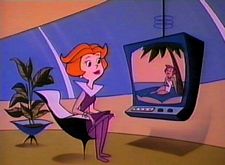  Cisco blog touts 1960s TV show!
 Cisco blog touts 1960s TV show!
Our most powerful modern myth is the notion of “progress” as defined by an every-expanding galaxy of consumer choices provided by that bubbling caudlron of double-double toil and trouble that is the global economy. And consumption is of course tightly tethered to advertising and branding, which are the mother’s milk of media, making the whole question of how to goose sales an issue of survival for us “content creators” whose works are the flypaper that Big Consumption uses to attract and retain ears and eyeballs.
So I was particularly amused to see TNS, one of the world’s leading advertising firms, summarize a report on a survey that asked consumers in Canada, China, France, Germany, Japan, Spain, the UK and US how they expect technology will change the nature of shopping in stores in the future. The summary says:
A confident 73% of shoppers globally say they expect to be using interactive touch screens in dressing rooms to communicate with sales assistants by 2015, while half or more expect that 3D body scanning and interactive dressing room mirrors will eliminate the stresses of trying on that new outfit.Â
Really? Will these 3-D programs also make you look just a wee bit slimmer? Or will a soothing mechanical voice of a gender appropriate to your shopper profile — hot or husky depending on your orientation –Â tell you that the outfit looks great on you? And will you be able to believe it?
The TNS summary offers no details regarding methodology which is OK given that it is a free teaser circulated to draw attention to what is presumably a costly and thorough analysis that global retail brands will buy and take seriously. We are not those people and so we can amuse outrselves by thinking how the future never really turns out to be like the predictions. The future almost always manages to catch us by surprise.
The cartoon above is, for instance, shows a character from the 1962 TV show, the Jetsons, talking into a videophone. A Cisco blog used that image in October to talk about a new telepresence technology. But after 40 plus years ordinary folks can now get telepresence of a sort for little more cost than access to a camera-carrying PC with Interent access. Longer lead times than expected but broader impact when it arrives. That’s my sense of how technology affects the future.